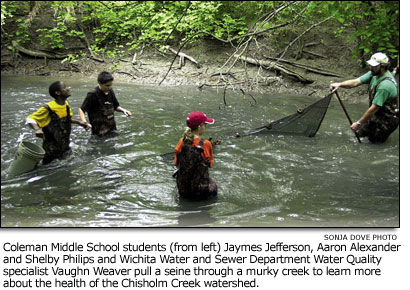| Clearing up muddy waters
Jason Project helps students make sense
of science education
BY RONALD BLISS

 Perhaps
one of the students with mud under her fingernails, a pant leg covered
with creek water and dirt on her knees said it best. Perhaps
one of the students with mud under her fingernails, a pant leg covered
with creek water and dirt on her knees said it best.
"I learned more in a few hours during a field trip than reading
about science from a textbook in a classroom for a whole semester."
About 100 seventh graders from Coleman Middle School in Wichita, Kan.,
spent much of one day recently at Chisholm Creek Park in Wichita, getting
wet in murky creek water, learning to spot poison ivy, checking core tree
samples to learn the ages of trees, and studying living critters that
call muddy creek banks home.
The students were taking part in a field trip as part of the Jason Project
for Science Education, an innovative approach to learning about science
and the environment. Boeing is a significant local sponsor for the Jason
Project and a regional sponsor as well.
"The things that we are studying in class, we are coming out and
seeing," said Randy Mousoey, Coleman Middle School teacher and leader
of the field trip. "We are looking at watershed health … The
whole concept is to come back year after year and keep collecting the
same kind of data, and we can get an idea of what the health is of the
Chisholm Creek watershed."
Jonathan Bradshaw, Education Relations specialist at Boeing Wichita,
said the Jason Project concept is a way for classroom teachers to reinforce
textbook material with real-world, hands-on activities that are fun and
exciting. Jason is a 3,000-year-old Greek mythological hero who led a
group of explorers called the Argonauts on a journey across the Black
Sea in search of the Fleece of the Golden Ram.
"It may be a cliché, but we're investing in our future
through education. We think education is the building block of strong
communities and a good quality of life. We support math and science education
because of that belief," Bradshaw said.
Mousoey said Boeing would receive payback in the future for its support.
"You may be getting some of these students in the workforce, and
they will have learned by being involved in projects like this that there
is more out of learning than reading from textbooks," he said. "They
are also learning the importance of teamwork and how important that is
in learning and working at a job."
The Jason Project for Science Education, in its 16th year, is a nationwide
effort to motivate teachers and provide professional development for them
in learning about the wonders of science using state-of-the-art technology.
The concept was developed by Dr. Robert Ballard, an explorer who helped
rediscover the RMS Titanic in 1986 and wanted to share his dream of exploration
and discovery with students everywhere.
ronald.g.bliss@boeing.com
|